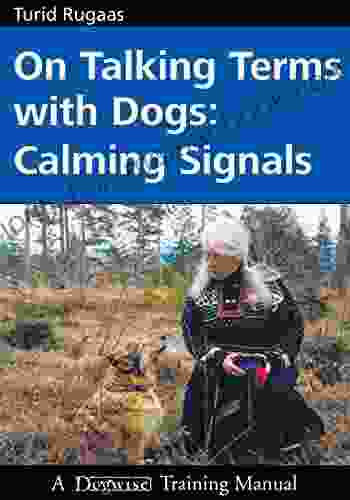On Talking Terms With Dogs: Calming Signals and the Language of Canine Communication

For centuries, dogs have been our loyal companions, sharing our homes and hearts. Yet, despite our close proximity, many of us struggle to fully understand the intricacies of canine communication. Dogs, like humans, possess a rich and complex language that extends beyond spoken words. By becoming familiar with the concept of calming signals, we can gain a deeper insight into the inner workings of our furry friends' minds.
What Are Calming Signals?
Calming signals are subtle body language cues that dogs use to communicate their emotions and intentions. These signals are not always obvious, but they are essential for maintaining harmony within a pack or family. When a dog feels stressed, anxious, or threatened, they may emit calming signals to avoid conflict and diffuse tension.
4.5 out of 5
| Language | : | English |
| File size | : | 4850 KB |
| Text-to-Speech | : | Enabled |
| Print length | : | 78 pages |
Understanding these signals is crucial for building a strong and respectful relationship with your dog. By recognizing when your dog is feeling uncomfortable or anxious, you can take steps to alleviate their stress and create a safe and nurturing environment.
Common Calming Signals
Below are some of the most common calming signals observed in dogs:
- Turning Away: When a dog averts their head or body away from you or another animal, they are indicating that they are uncomfortable and do not want to interact.
- Licking Lips: Dogs may lick their lips when they are feeling anxious or submissive. This behavior is often accompanied by other calming signals, such as yawning or avoiding eye contact.
- Yawning: While it may seem like a sign of sleepiness, yawning in dogs is often a calming signal that indicates discomfort or stress.
- Avoiding Eye Contact: Dogs that avoid direct eye contact are typically feeling shy, insecure, or threatened. Avoiding eye contact can also be a sign of respect toward dominant dogs.
- Freezing: If a dog suddenly stops moving and remains perfectly still, they may be trying to calm themselves down or avoid confrontation. This behavior can be a response to fear, anxiety, or excitement.
- Sitting or Lying Down: Similar to freezing, a dog that sits or lies down may be trying to de-escalate a stressful situation. They are essentially making themselves less threatening by lowering their body.
- Tail Tucking: Tucking the tail between the legs is a classic sign of fear or submission. This behavior is often accompanied by other calming signals, such as licking lips or avoiding eye contact.
Decoding Calming Signals
The key to decoding calming signals is to observe your dog's overall body language and behavior. Calming signals are often subtle and may be easily overlooked. However, by paying attention to the following cues, you can better understand what your dog is trying to communicate:
- Context: Consider the situation in which your dog is displaying the calming signal. Are they in a new environment, interacting with strangers, or feeling overwhelmed? Understanding the context can help you interpret the signal accurately.
- Body Language: Observe your dog's entire body posture, including their head, tail, ears, and limbs. Subtle shifts in body language can provide valuable insights into their emotional state.
- Facial Expressions: Dogs communicate a wide range of emotions through their facial expressions. Pay attention to their eyes, mouth, and ears for clues about their mood and intentions.
- Verbal Cues: While dogs primarily communicate through body language, they may also use vocalizations to convey their emotions. Listen for whining, growling, or barking that may accompany calming signals.
Using Calming Signals to Improve Dog-Human Relationships
By understanding calming signals, you can become more attuned to your dog's emotional needs and improve your communication with them. Here are a few tips for using calming signals to enhance your dog-human relationship:
- Respect Calming Signals: When your dog displays calming signals, it is important to respect their space and give them time to calm down. Avoid approaching them directly or making sudden movements that may startle them.
- Use Calming Signals: You can use calming signals to communicate with your dog in a non-threatening way. For example, turning your head away, licking your lips, or yawning can indicate that you are feeling relaxed and non-aggressive.
- Create a Calming Environment: Provide your dog with a safe and comfortable space where they can retreat to when feeling stressed or overwhelmed. This could be a quiet corner of the house or a designated crate.
- Avoid Punishment: Punishing your dog for displaying calming signals can damage your relationship and make them less likely to communicate their emotions openly with you.
Calming signals are an essential part of canine communication. By understanding and respecting these signals, we can build stronger bonds with our furry companions and create a harmonious and mutually fulfilling relationship. By becoming more attuned to our dogs' body language, we can better meet their needs, reduce stress, and foster a lifetime of love and companionship.
Remember, every dog is an individual, and their use of calming signals may vary. It is important to observe your dog closely and learn their unique communication style. With patience, empathy, and a willingness to learn, you can become proficient in "talking terms" with your dog and unlock the secrets of their inner world.
4.5 out of 5
| Language | : | English |
| File size | : | 4850 KB |
| Text-to-Speech | : | Enabled |
| Print length | : | 78 pages |
Do you want to contribute by writing guest posts on this blog?
Please contact us and send us a resume of previous articles that you have written.
 Top Book
Top Book Novel
Novel Fiction
Fiction Nonfiction
Nonfiction Literature
Literature Paperback
Paperback Hardcover
Hardcover E-book
E-book Audiobook
Audiobook Bestseller
Bestseller Classic
Classic Mystery
Mystery Thriller
Thriller Romance
Romance Fantasy
Fantasy Science Fiction
Science Fiction Biography
Biography Memoir
Memoir Autobiography
Autobiography Poetry
Poetry Drama
Drama Historical Fiction
Historical Fiction Self-help
Self-help Young Adult
Young Adult Childrens Books
Childrens Books Graphic Novel
Graphic Novel Anthology
Anthology Series
Series Encyclopedia
Encyclopedia Reference
Reference Guidebook
Guidebook Textbook
Textbook Workbook
Workbook Journal
Journal Diary
Diary Manuscript
Manuscript Folio
Folio Pulp Fiction
Pulp Fiction Short Stories
Short Stories Fairy Tales
Fairy Tales Fables
Fables Mythology
Mythology Philosophy
Philosophy Religion
Religion Spirituality
Spirituality Essays
Essays Critique
Critique Commentary
Commentary Glossary
Glossary Bibliography
Bibliography Index
Index Table of Contents
Table of Contents Preface
Preface Introduction
Introduction Foreword
Foreword Afterword
Afterword Appendices
Appendices Annotations
Annotations Footnotes
Footnotes Epilogue
Epilogue Prologue
Prologue Michael Collins
Michael Collins Jake Bright
Jake Bright Jimmy Moncrief
Jimmy Moncrief Debbie Steglic
Debbie Steglic Robert Scheyer
Robert Scheyer Jorge Madriz
Jorge Madriz James Swallow
James Swallow Suzuki Aika
Suzuki Aika Leah Vernon
Leah Vernon Gina Robinson
Gina Robinson Jennifer Rayes
Jennifer Rayes Sunil Singh
Sunil Singh Stephanie L Smith
Stephanie L Smith Jane K Brown
Jane K Brown Robert F Kennedy Jr
Robert F Kennedy Jr Christopher Charlton
Christopher Charlton Daniel Alef
Daniel Alef Craftdrawer Craft Patterns
Craftdrawer Craft Patterns Roddy Lumsden
Roddy Lumsden Jack Daniels
Jack Daniels
Light bulbAdvertise smarter! Our strategic ad space ensures maximum exposure. Reserve your spot today!
 Edgar HayesFollow ·8.4k
Edgar HayesFollow ·8.4k Edwin CoxFollow ·16.9k
Edwin CoxFollow ·16.9k Jaylen MitchellFollow ·13k
Jaylen MitchellFollow ·13k Peter CarterFollow ·7.3k
Peter CarterFollow ·7.3k Hamilton BellFollow ·11.1k
Hamilton BellFollow ·11.1k Jaime MitchellFollow ·11.7k
Jaime MitchellFollow ·11.7k Douglas AdamsFollow ·6.4k
Douglas AdamsFollow ·6.4k Dakota PowellFollow ·10.8k
Dakota PowellFollow ·10.8k

 Steve Carter
Steve CarterUnveiling the Rich Theatrical Tapestry of Russia: A...
Origins and Early...

 Frank Butler
Frank ButlerOn Talking Terms With Dogs: Calming Signals and the...
For centuries, dogs have...

 Leo Tolstoy
Leo TolstoyThe Inside Guide to Applying and Succeeding in...
Applying to...

 Cole Powell
Cole PowellThe Political Economy of Global Finance, Farming and...
The global...
4.5 out of 5
| Language | : | English |
| File size | : | 4850 KB |
| Text-to-Speech | : | Enabled |
| Print length | : | 78 pages |















